Weekly Reports from Jordan
Choose Year: or Choose week
The A-Bee-Cs of Digging
Larry G. Herr and Douglas R. Clark
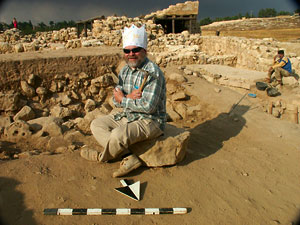 If you have never been part of an archaeological dig, you may wonder what you would have to do to learn how to dig. Would you simply slip on your tan-colored clothing; pat the hat on your head; grab your trowel, hand pick, dustpan, and guffa (a basket made from old car tires); and mutter, "Now show me a tell!?"
If you have never been part of an archaeological dig, you may wonder what you would have to do to learn how to dig. Would you simply slip on your tan-colored clothing; pat the hat on your head; grab your trowel, hand pick, dustpan, and guffa (a basket made from old car tires); and mutter, "Now show me a tell!?"
Maybe the movies present it that way, but that's not how an actual archaeological dig does it. During orientation last week, we went through a lot of rules about how to dig and how to keep the proper records. But that was all theory. This week we did it at the 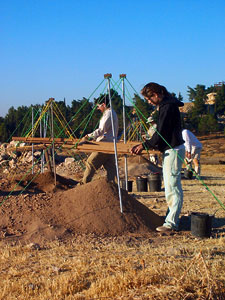 site and, day by day, everyone learned more and more, becoming more efficient, understanding archaeological strategies better, and beginning to understand and use the talents and skills of fellow workers, complementing each other as a team.
site and, day by day, everyone learned more and more, becoming more efficient, understanding archaeological strategies better, and beginning to understand and use the talents and skills of fellow workers, complementing each other as a team.
In Field A, supervised by Bob Bates, everyone learned about balks (those narrow walls of dirt and rubble we leave between the excavated areas or "squares") and how to remove them in small spaces. Indeed, in three squares participants learned how to "reverse draw" those balks. This is an advanced method we usually try to leave until further along in the dig, but diggers in three squares learned it very quickly: Tom Venner, Kassie Skoretz, and Heather Merizan in one square; Caroline Houghton, Myron Widmer, and Steven Salcido in a second square; and Deborah Haberman, Christina Widmer, and Aaron Davis in a third square.
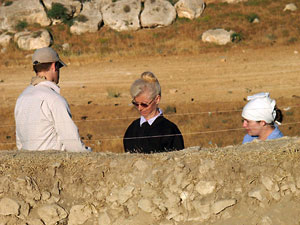 Everyone soon learns how to draw balks—those precise drawings that show the relationship of earth layers to walls and other features. But these people, digging in small, constricted spaces, had to demolish their balks before one side of them could be drawn. That means they took out the balks, leaving the debris in the actual square. Then they drew that debris and traced it in a reverse fashion on a light table (or window). Sound complicated? It is—somewhat, until you learn how to do it.
Everyone soon learns how to draw balks—those precise drawings that show the relationship of earth layers to walls and other features. But these people, digging in small, constricted spaces, had to demolish their balks before one side of them could be drawn. That means they took out the balks, leaving the debris in the actual square. Then they drew that debris and traced it in a reverse fashion on a light table (or window). Sound complicated? It is—somewhat, until you learn how to do it.
Other teams in Field A were excavating in less restricted space. One team (Audrey Shaffer, Erica Hufnagel, and Derek Bobst) worked quickly through a deep layer of topsoil on the upper slope of the site to find the city wall or at least a surface running to a gate through the wall. Another team (Brenda Adams, Tyler Mitchell, and Amy Bellinghausen) busily uncovered a series of debris layers with lots of reconstructable pottery belonging to a period that has, so far, been quite rare at `Umayri, the 8th to 7th centuries BC. This rare find caused Larry Herr to hang about the square more than usual.
In Field B, supervised by Kent Bramlett, we have learned one of the most basic of excavation skills: how to find the bottom of one layer of debris and then to excavate the next layer. Unfortunately, the sins of our past are returning to haunt us. In earlier seasons we sifted our debris where now, it turns out, we must excavate. This means several of the diggers in Field B are becoming expert at separating old sift debris from original topsoil. Such is the fate of two squares, including Ellen Bedell, Bethany Reiswig, Carolyn Waldron, Boris Brajnikoff, and Anneliese Weiss. When they have removed all the old sift debris they will find the northern limits of the Late Bronze Age palace from the time of biblical Moses (about 1400 BC).
The other squares in Field B (with Janelle Worthington, Monique Acosta, Katie van Petten, Lindsey Hill, and Allison Hade) are searching for rooms and floors in the Late Bronze Age palace with the aim of finding the floors and the main entrance to the building. This means removing a balk in one square and excavating the last of the Iron II (7th and 6th centuries BC) layers. Strangely, there are no remains dating between the Iron II period and the Late Bronze Age in this part of Field B. We hope the complete palace will be exposed by the end of the season.
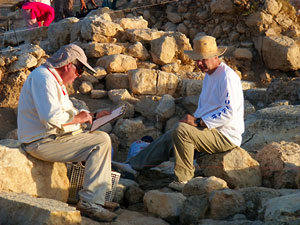 In Field H, supervised by David Berge, we are learning how to bring squares into phase with each other. What does that mean? Archaeologists like to excavate remains from the same period (or "phase") in adjacent squares. The added horizontal exposure helps us understand better what we find. The excavators of two squares (Jeannie DelColle, Don Mook, Larry Murrin, Stefanie Elkins, Barbera van Viersen Trip, Sean Haskell, and Erin Carr) are already digging beneath the floor of an open-air sanctuary that dates to the late Iron I period (about 1100 BC).
In Field H, supervised by David Berge, we are learning how to bring squares into phase with each other. What does that mean? Archaeologists like to excavate remains from the same period (or "phase") in adjacent squares. The added horizontal exposure helps us understand better what we find. The excavators of two squares (Jeannie DelColle, Don Mook, Larry Murrin, Stefanie Elkins, Barbera van Viersen Trip, Sean Haskell, and Erin Carr) are already digging beneath the floor of an open-air sanctuary that dates to the late Iron I period (about 1100 BC).
However, the two squares to the south (with Julie Cormack, Jillian Logee, Russ Dedul, Marcin Czarnowicz, Aga Ochal, and Nikki Oakden) are still in the late Iron II period (7th-6th centuries BC). They are working hard to remove floors and excavate to the bottom of walls, so they can remove the Iron II material and arrive at the late Iron I ruins.
In Field L, supervised by David Hopkins and Mary Boyd, the team is learning how to separate topsoil levels from sub-topsoil with the change from gray-colored earth to debris with a more tan color. Steve Barbery, Greg Kremer, Michael Dubbs, Tom Tipton, Charles Harris, and Laura King have done this even while learning how to use the big pick to remove almost half a meter of topsoil (including). The third team (Jen Harris and Henry Hopkins) is learning how to clean stones in a pile of rubble, while searching for elusive wall lines before removing the stones. All these teams have begun to discover the tops of ancient walls.
 But the big story of the week in Fields H and L has been learning to cope with an invasion of bees! The keeper of the beehives that have existed on the southern slope of the site for several seasons decided to move them on Tuesday. The angry bees proceeded to blame us for the absence of the tops of their hives. Total stings to our team numbered 51 that day, with the honor for most stings going to Greg Kremer with seven! This influx stopped work in those two fields for a while and a number of people had uncomfortable swollen areas on their bodies. It shows the dedication of our group that they went right back to work when the invasion lessened thanks in part to a smoky fire we built upwind. It also helped that the temperatures moderated significantly toward the end of the week to bring heavy morning clouds.
But the big story of the week in Fields H and L has been learning to cope with an invasion of bees! The keeper of the beehives that have existed on the southern slope of the site for several seasons decided to move them on Tuesday. The angry bees proceeded to blame us for the absence of the tops of their hives. Total stings to our team numbered 51 that day, with the honor for most stings going to Greg Kremer with seven! This influx stopped work in those two fields for a while and a number of people had uncomfortable swollen areas on their bodies. It shows the dedication of our group that they went right back to work when the invasion lessened thanks in part to a smoky fire we built upwind. It also helped that the temperatures moderated significantly toward the end of the week to bring heavy morning clouds.
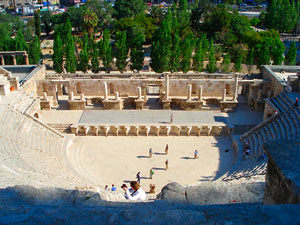 But archaeology is more than just digging. It is also learning about the region in which we dig, bringing a sense of context to what we do. On Sunday we took a trip around Amman, visiting the Roman ruins of the Decapolis city called Philadelphia at that time. We saw the large theatre, the Nymphaeum, and the Odeon (a small intimate theatre seating 600). We traveled past the largest Stone Age site in the region called Ain Ghazal. We ascended the citadel hill above the theatre and saw the site where King David's army fought the Ammonites and where Uriah the Hittite, Bath Sheba's husband of biblical lore, was
But archaeology is more than just digging. It is also learning about the region in which we dig, bringing a sense of context to what we do. On Sunday we took a trip around Amman, visiting the Roman ruins of the Decapolis city called Philadelphia at that time. We saw the large theatre, the Nymphaeum, and the Odeon (a small intimate theatre seating 600). We traveled past the largest Stone Age site in the region called Ain Ghazal. We ascended the citadel hill above the theatre and saw the site where King David's army fought the Ammonites and where Uriah the Hittite, Bath Sheba's husband of biblical lore, was 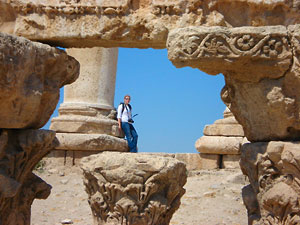 killed. We also saw the very large Roman temple of Hercules, the Amman Archaeological Museum, and a wonderfully reconstructed palace from the time of Umayyad caliphs—the first dynasty of Islamic rulers whose capital city was Damascus. Finally, we visited ACOR—the American Center of Oriental Research—the institution with which we cooperate while here and which serves us as a research center.
killed. We also saw the very large Roman temple of Hercules, the Amman Archaeological Museum, and a wonderfully reconstructed palace from the time of Umayyad caliphs—the first dynasty of Islamic rulers whose capital city was Damascus. Finally, we visited ACOR—the American Center of Oriental Research—the institution with which we cooperate while here and which serves us as a research center.
We also learned about our own site. Friday at 11:30 is a weekly time set apart for a "Tour of the Tell." Everyone visits every Field of excavation to find out what everyone else on the team is doing.
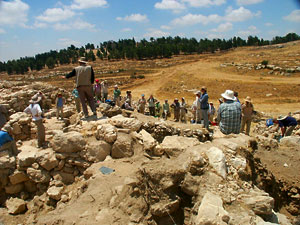 |
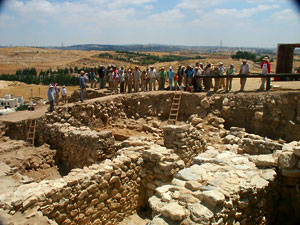 |
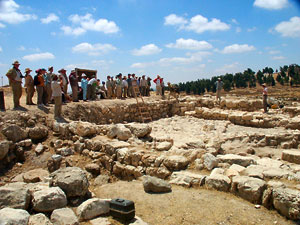 |
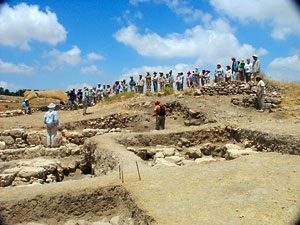 |
 Sounds like a busy week. It was. But we also had time to celebrate. On July 1 it was Canada Day, celebrated by wishing Canada a happy birthday, complete with a red-and-white birthday cake and the 11 Canadia
Sounds like a busy week. It was. But we also had time to celebrate. On July 1 it was Canada Day, celebrated by wishing Canada a happy birthday, complete with a red-and-white birthday cake and the 11 Canadia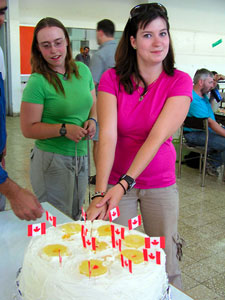 ns singing the national anthem. Three days later it was the 4th of July. Another cake and another national anthem sung with gusto.
ns singing the national anthem. Three days later it was the 4th of July. Another cake and another national anthem sung with gusto.
We also celebrated the arrival of Bob Bates' family, including his wife Nerida and three young daughters – twins Jessica and Elizabeth, and Becky. Children help lighten our experience and help keep us balanced. Nerida is a pediatrician and has already helped nurse Carolyn Waldron with some of our camp and site 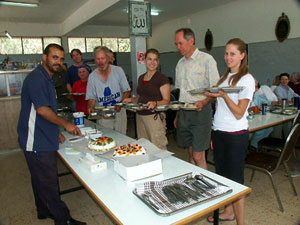 ailments. She is also a professor of medicine at Loma Linda University and is teaching part time at the University of Jordan for the three weeks while she is here.
ailments. She is also a professor of medicine at Loma Linda University and is teaching part time at the University of Jordan for the three weeks while she is here.
We were saddened early in the week to learn that Anneliese Weiss's mother had passed away in Germany. Fortunately, Anneliese was able to arrange for a flight to Germany to be with her family and then return by Friday so eager to dig that she did not sleep after a red-eye special from Germany, but joined us for a full day of digging.
Archaeology is a team endeavor and we all learn as we go along. Even those of us who have excavated for many years still learn. The ancient world has much to teach us. And we continue to make sacrifices to be in Jordan for this very privilege.
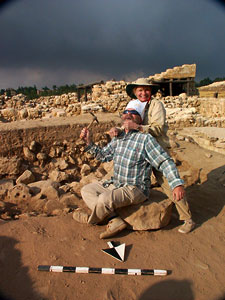 |
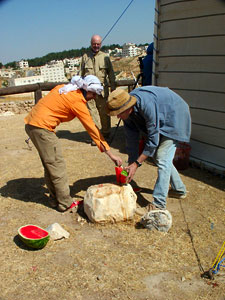 |
Photos by Doug Clark unless otherwise indicated.